
Jefferson Yarce
In order to address this question, Upper Triassic to Middle Jurassic Arcs defined by Hildebrand (2013) were investigated in terms of its trace element content following a discriminating criteria for the different tectonics environments, by comparing with widely accepted examples for each magma generator environment.
First, a little review of the geochemistry for each tectonic setting is provided:
1.1 Island arc magmatism
Is related to the volcanism that is generated in an intra-oceanic subduction setting, where an oceanic plate subducts beneath another oceanic plate. Common examples of this kind of magmatism is usually represented by Papua-New Guinea, The Antilles and the Aleutians islands [Winter, 2001]. Rare-earth elements (REE) chemistry of island arc magmatism is represented usually by a continuous slope distribution for almost any SiO2 variation. Negative Eu anomalies are usually developed in the high-SiO2curves (Figure 1).
 |
Figure 1 . Chondrite-normalized REE diagrams for representative island arc volcanic rock [Winter, 2001]. |
For a broader distribution of trace elements, a spider diagram is used. This are particularly useful, since they are less affected by fractional crystallization or contamination [Winter, 2001]. For island arc, the LIL elements (Sr, K, Rb, Ba) are enriched respect to the MORB-normalized diagrams. A negative Nb anomaly is usually present in the diagrams; however, authors are not completely agree in whether or not this Nb signature is due to a oceanic-oceanic subduction magmatic residue or a contamination from a MORB-like source.
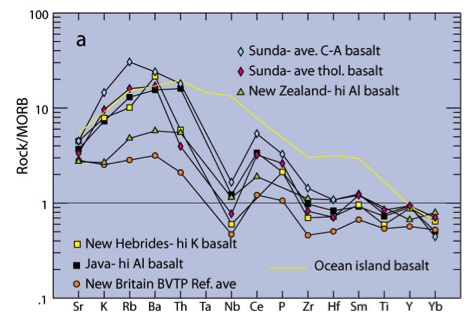 |
Figure 2 . MORB-normalized spider diagrams for selected island arc magmas [Winter, 2001]. |
1.2 Continental arc magmatism.
In a similar systematic as described above, the chondrite-normalized REE diagram shows for continental arc magmas an enrichment in the HREE respect to the LREE as it is expected when a thick continental crust is involved [Winter, 2001] (Figure 3).
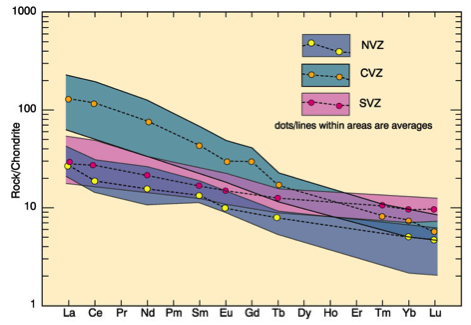 |
Figure 3 . Chondrite-normalized REE diagrams for continental arc magmas [Winter, 2001]. |
Figure 4 is the spider diagram in which the LIL’s and HFS’s shows the enriched-depleted pattern. The figure also shows the Nb-Ta negative anomaly that is widely considered as a magma subduction-related signature. Note that the CVZ (Central Volcanic Zone) magmas shows an enrichment in Ta, Nb, Zr and Hf that probably represents an involvement of subcontinental lithosphere mantle.
 |
Figure 4 . MORB-normalized spider diagram for continental arc magmas [Winter, 2001]. |
1.3 Back-arc basin magmatism
Distinction of Back-Arc Basin Basalts (BABB) from mid ocean ridge was difficult to achieved; however Pearce and Stern (2013) argued that these kind of magmas are transitional between ocean-floor and island-arc tholeiites, sharing with the latter their higher Rb, Ba, and LREE contents, and lower Ti, Zr and Hf contents. BABBs are characterized as having increased concentrations of LILs, reduced concentrations of HFSs.
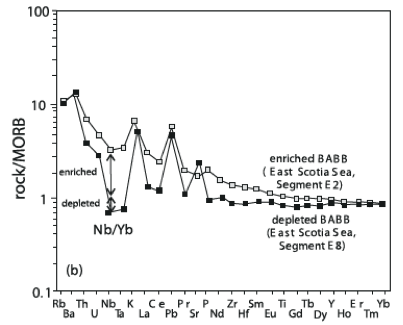 |
Figure 5. N-MORB normalized trace elements for enriched and depleted BABB [Pearce and Stern, 2013]. |
2.1 Talkeetna Arc
The Talkeetna Arc represents the northernmost exposure of magmatism in this range of time in the considered Rubia terrane from Hildebrand (2013) in the western margin of North America. This rocks are constrained in age between 207 and 172 Ma [Green et al., 2006; Rioux et al., 2007]. The REE and trace element diagrams for the Talkeetna arc, shows the characteristic regular slope with Eu negative anomaly and the negative anomaly for Nb and Ta, respectively; for the common island arc volcanism (Figure 1 and Figure 2 ). This is consistent with Green et al., (2006) as having formed in an island arc setting within an oceanic crust.
 |
| Figure 6. Whole rock chemistry for volcanic rock in Talkeetna arc [Green et al., 2006]. |
2.2 Bonanza Arc
The Bonanza arc is mostly composed of lava, tuff and breccias ranging in age from 190 to 169 Ma [Hildebrand, 2013]. REE and trace element chemistry shows that sampled were similarly enriched in LILs (Rb, Ba, K, Pb, and Sr) relative to the MORB and showed negative Nb, Ta, and Ti anomalies (Figure 7 ). Chondrite-normalized rare earth element (REE) patterns for the samples in this study all showed light REE (La to Sm) enrichment relative to the middle and heavy REE (Eu to Lu) values (Figure 7 ). Bonanza arc shows relatively very similar signatures to island arc magmatism; however, it is not completely clear, since the rocks appear to have an age-controlled bimodal distribution that makes it hard to define their composition in terms of tectonic environment [D’Souza et al., 2016].
 |
| Figure 7 . Trace element profiles [D’Souza et al., 2016] |
2.3 Klamath Arcs
For the Klamath mountains arc, the geochemical data shows that the two geologically distinct igneous units mapped in the Hayfork Summit area (Hayfork Summit metabasalts and mafic igneous rocks in serpentinite mélange) are chemically distinct. Trace element abundances for Hayfork Summit metabasalts exhibit OIB patterns, decreasing steadily from LREEs to HREEs and lacking significant negative Nb and Ta anomalies (Figure 8 ). Metabasalt, metagabbro, and metadiorite blocks in the serpentinite matrix mélange have nearly flat trace element abundance patterns, similar to MORB; most analyzed samples are enriched in Ba, K, and Sr relative to normal MORB (N-MORB [Scherer et al., 2006]. In other study, the Ironside Mountain–type magmatism is unusual relative to other Klamath plutonism and this one probably occurred in a postcontractional tectonic setting. [Barnes et al., 2006]
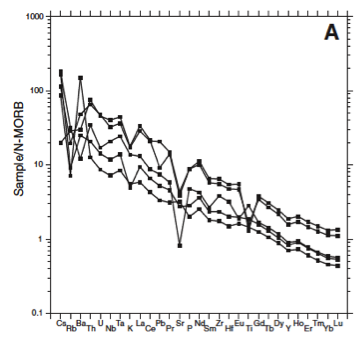 |
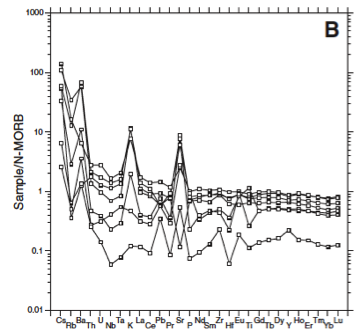 |
|
| Figure 8. Spider diagrams for two distinct facies in Klamath mountains (a) Ocean-island metabasalts associated with metasedimentary strata. (b) Basalt and gabbro blocks [Scherer et al., 2006]. | ||
Figure 9 clearly shows all of the signatures expected of subduction zone magmatism. The rocks shows negative anomalies of Nb, Ta, and TiO2 and by high abundances of LILs. The resultant trace element patterns are characteristic of arc magmas (island or continental arc) [Barnes et al., 2006].
 |
| Figure 9 . Chondrite Normalized REE [Barnes et al., 2006] |
It is now clear that the arc exposed in the Klamath mountains does not have a specific and characteristic tectonic environment regional for the entire mountains, and that their chemical signature can be local.
2.4 Smartville Arc
For the Smartville Complex rocks (155 to 164 Ma in age), geochemistry of REE and trace elements shows similarities to the common island arc magmatism, with the relative enrichment in LIL elements and the regular slope for REE with some anomalies of Eu in some of their samples [Metzger et al., 2002].
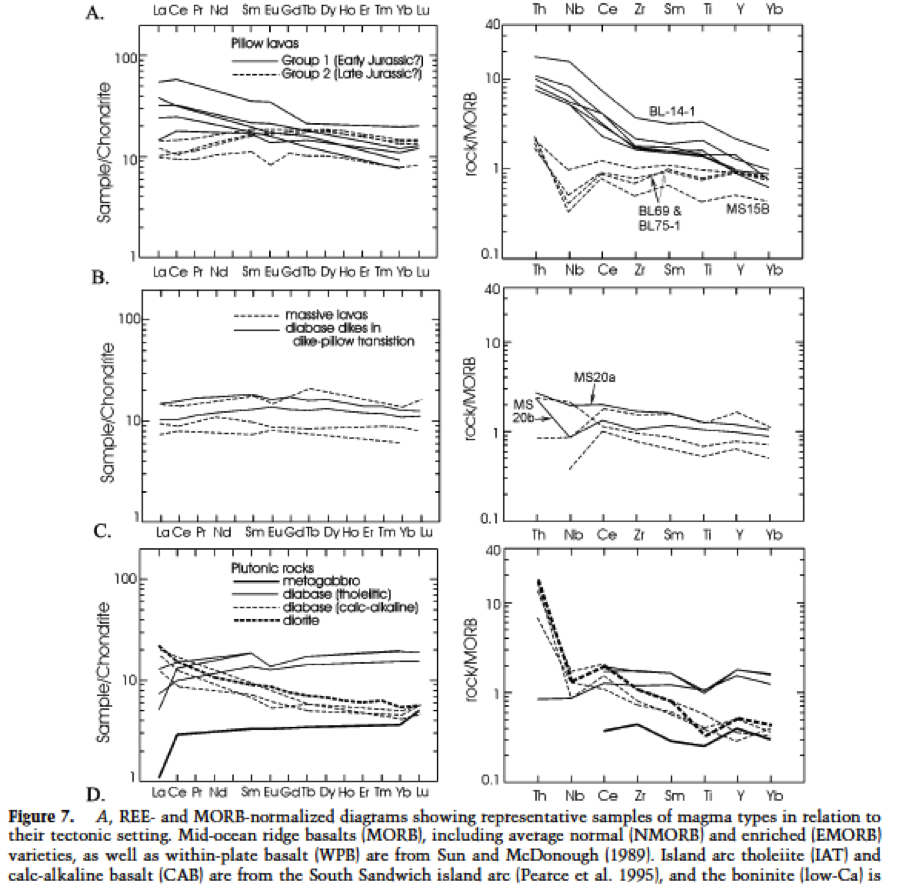 |
| Figure 10. REE and MORB-normalized diagrams [Metzger et al., 2002] |
2.5 Sierran Jurassic Arc
The low Nb and Ta anomalies, together with the enrichment in LILs shown in Figure 11 , show a probable continental magmatic arc signature. These rocks correspond to granodiorites, granites and tonalities, which have associated mafic magmatic enclaves and dikes emplaced in the called Jurassic plutons and suites [Barbarin, 2005].
 |
Figure 11 . REE normalized patterns for Sierran batholiths [Barbarin, 2005] |
2.6 Jurassic Slab Failure Magmatism
Also included in the time constrain of arcs from the Triassic to early Cretaceous, the Slab Failure Magmatism of the Independence Dike Swarm in San Bernardino (California) [Hildebrand, 2013]. A relative low content of HREE with a negative Eu anomaly shown in Figure 13 , suggest calc-alkaline magmatism related to continental arc plutonism [Mcmanus and Clemens-knott, 1997].
More recent trace element distributions in the Independence Dikes, shows chemical similarities with the Sierra Nevada Cretaceous plutons [Glazner et al., 2008]. This dikes indicate enrichments in the most incompatible elements, negative Nb and Ta anomalies and note very deep Eu trough. This distributions could be representative of continental arc magmatism.
 |
| Figure 12. Chondrite normalized diagrams for Independence Dikes [Glazner et al., 2008] |
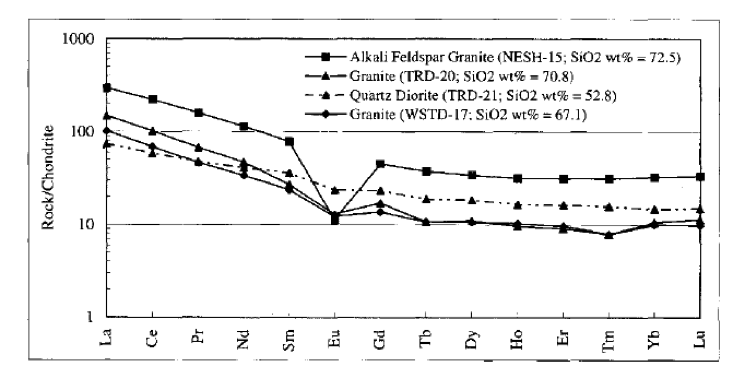 |
| Figure 13 . REE plot of representative dikes normalized to the chondrite [McManus and Clemens-Knott, 1997]. |
A complex variation of results for different places and magmatic occurrences between the Triassic and Early Cretaceous, including a slab failure magmatism, does not shows a consistent geochemical content, without indicating a particular tectonic environment. A consistent subduction-related signature is common to all the arc considered in this document for the time period considered.
REFERENCES
Hildebrand, R. S. (2013), Mesozoic assembly of the North American Cordillera, Geol. Soc. Am. Spec. Pap., 495, 1–169, doi:10.1130/2013.2495.(a) - 10.1130/2013.2495.(d).
McManus, S. G., and D. Clemens-Knott (1997), Geochemical and oxygen isotope constraints on the petrogenesis of the Independence dike swarm, San Bernardino, Co., California, in Geology of the Western Cordillera: Perspectives from Undergraduate Research: Long Beach, California, Pacifi c Section, SEPM, Society for Sedimentary Geology, vol. 82, edited by J. D. Girty, G.H., and Cooper, pp. 91–102, Society for Sedimentary Geology.
Winter, J. D. (2001), An Introduction to Igneous and Metamorphic Petrology.: By . Prentice-Hall Inc. xx + 697 pages, ISBN 0-13-240342-0.